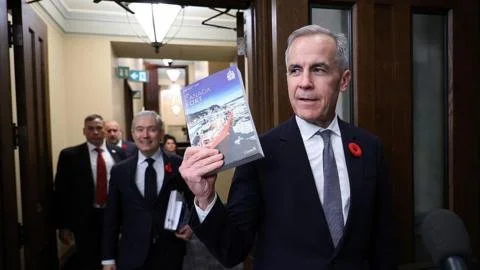Tariff Turmoil: Carney's Bold Budget Aims to Transform Canada's Economy
Canada’s Prime Minister Mark Carney has unveiled a historic federal budget amid the tumult of US tariffs, marking his first as Prime Minister. Dubbed an ”investment budget,” it will escalate Canada’s deficit to C$78 billion (approximately $55.3 billion), the second-largest deficit in Canadian history. Despite the significant deficit, Carney’s government aims to attract C$1 trillion of investment into the country over the next five years, arguing that more cautious spending would jeopardize critical social programs and future funding.
In a stark warning, Finance Minister François-Philippe Champagne articulated that Canada is undergoing ”a time of profound change” necessitating ”bold and swift action”. He emphasized the pervasive uncertainty stemming from US protectionist measures, particularly President Donald Trump’s 35% tariffs on Canadian goods, leading to job losses and a shrinking investment landscape. As a countermeasure, the budget proposes an ambitious C$280 billion investment over the next five years to enhance Canada’s productivity, competitiveness, and resilience.
Key initiatives include updating ports and trade infrastructure with the goal of doubling non-US exports over the next decade, alongside direct financial aid to support companies affected by tariffs. The budget also outlines a strategy to make Canada more appealing for business than the US.
However, Rebekah Young from Scotiabank cautions that the budget might be unsatisfactory for Canadians facing immediate cost-of-living challenges as it lacks new forms of support. Although it aims for substantial investment growth, the uncertainty remains about whether it will achieve the transformational impact Carney envisions. The budget pledges C$82 billion toward defense, marking the largest commitment in years, aligning with Canada’s NATO obligations. Additionally, there is a notable focus on artificial intelligence, with C$1 billion earmarked for its integration and application across various sectors.
On the downside, sacrifices will come in the form of a 10% reduction in the federal workforce, resulting in approximately 40,000 job losses by 2029. International aid will also revert to pre-pandemic levels, and immigration targets are slightly lowered to stabilize new admissions, including a significant cut in student visas.
Carney’s fiscal plan is subject to parliamentary approval, where his Liberal government – not quite a majority – must gain support from other parties. Criticism arises particularly from Conservative and Bloc Québécois leaders about the increase in national deficit without adequate relief for affordability. Opposition reveals a division regarding public sector cuts and the anticipated impacts of the burgeoning fiscal deficit, though the government maintains it has the lowest deficit-to-GDP ratio among G7 nations, second only to Japan.

